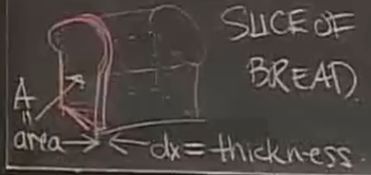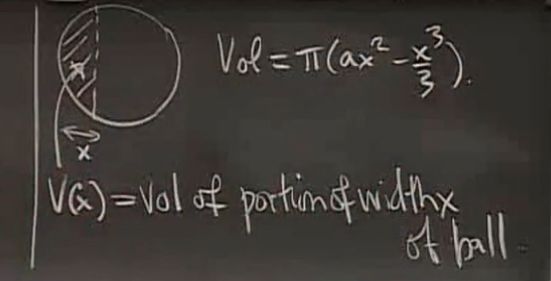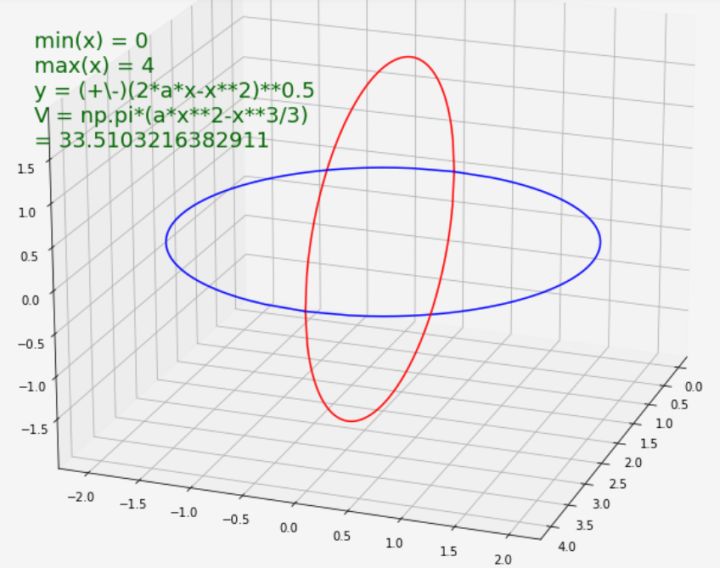本文内容来自于学习麻省理工学院公开课:单变量微积分-壳层法、圆盘法求体积-网易公开课
一、切片法球体积 (继续建立积分的思想)

?
?
如图, 红色切片部分的体积
这个式子取极限,则有
全部面积为
二、旋转立方体(solids of revolution)
圆盘法介绍:
老师先画了一条x轴上方曲线,看着像sinx, 之后出题,这个曲线绕x轴一周形成一个椭圆,可以猜想,当对这个椭圆切片,可以得到一个?,因为图形绕x轴旋转不会改变函数值到x轴的距离,而这个距离就是这个?的半径。
于是有公式 ,假设这个曲线就是sin(x), 于是有体积公式
?
from sympy import *
import matplotlib.pyplot as plt
import numpy as np
from enum import Enum
from itertools import product, combinations
from matplotlib import cm
from matplotlib import pyplot as plt
from mpl_toolkits.mplot3d.art3d import Poly3DCollection, Line3DCollection
from mpl_toolkits.mplot3d import Axes3D
fig = plt.figure(figsize=(12, 12),
facecolor='lightyellow'
)
# draw sphere
ax = fig.gca(fc='whitesmoke',
projection='3d'
)
class EnumAxis(Enum):
XAxis = 1
YAxis = 2
ZAxis = 3
def fromXYZM(xyzM):
ret = []
m=range(0,xyzM.shape[0])
for b in zip(m,[0]):
ret.append((xyzM[b]))
for b in zip(m,[1]):
ret.append((xyzM[b]))
for b in zip(m,[2]):
ret.append((xyzM[b]))
return ret
def plot_surface(x, y, z, dx, dy, dz, ax):
xx = np.linspace(x, x+dx, 2)
yy = np.linspace(y, y+dy, 2)
zz = np.linspace(z, z+dz, 2)
if(dz == 0):
xx, yy = np.meshgrid(xx, yy)
ax.plot_surface(xx, yy, z, alpha=0.25)
if(dx == 0):
yy, zz = np.meshgrid(yy, zz)
ax.plot_surface(x, yy, zz, alpha=0.25)
if(dy == 0):
xx, zz = np.meshgrid(xx, zz)
ax.plot_surface(xx, y, zz, alpha=0.25)
def plot_opaque_cube(x, y, z, dx, dy, dz, ax):
xx = np.linspace(x, x+dx, 2)
yy = np.linspace(y, y+dy, 2)
zz = np.linspace(z, z+dz, 2)
xx, yy = np.meshgrid(xx, yy)
ax.plot_surface(xx, yy, z)
ax.plot_surface(xx, yy, z+dz)
yy, zz = np.meshgrid(yy, zz)
ax.plot_surface(x, yy, zz)
ax.plot_surface(x+dx, yy, zz)
xx, zz = np.meshgrid(xx, zz)
ax.plot_surface(xx, y, zz)
ax.plot_surface(xx, y+dy, zz)
# ax.set_xlim3d(-dx, dx*2, 20)
# ax.set_xlim3d(-dx, dx*2, 20)
# ax.set_xlim3d(-dx, dx*2, 20)
def DrawAxis(ax, xMax, yMax, zMax):
# 设置坐标轴标题和刻度
ax.set(xlabel='X',
ylabel='Y',
zlabel='Z',
xticks=np.arange(-xMax, xMax, 1),
yticks=np.arange(-yMax, yMax, 1),
zticks=np.arange(-zMax, zMax, 1)
)
ax.plot3D(xs=[xMax,-xMax, 0,0, 0, 0, 0,0, ], # x 轴坐标
ys=[0, 0,0, yMax,-yMax, 0, 0,0, ], # y 轴坐标
zs=[0, 0,0, 0,0, 0, zMax,-zMax ], # z 轴坐标
zdir='z', #
c='k', # color
marker='o', # 标记点符号
mfc='r', # marker facecolor
mec='g', # marker edgecolor
ms=10, # size
)
def Rx(x,y,z,theta):
A = [x,y,z] * np.matrix([[ 1, 0 , 0 ],
[ 0, cos(theta),-sin(theta)],
[ 0, sin(theta), cos(theta)]])
return fromXYZM(A)
def Ry(x,y,z,theta):
A = [x,y,z] * np.matrix([[ cos(theta), 0, sin(theta)],
[ 0 , 1, 0 ],
[-sin(theta), 0, cos(theta)]])
return fromXYZM(A)
def Rz(x,y,z,theta):
A = [x,y,z] * np.matrix([[ cos(theta), -sin(theta), 0 ],
[ sin(theta), cos(theta) , 0 ],
[ 0 , 0 , 1 ]])
return fromXYZM(A)
def XYRotateByAxis(xFrom,xTo,steps,expr,theta,color,ax,rotatedBy):
yarr = []
xarr = np.linspace(xFrom ,xTo, steps)
xyz = []
xx = []
yy = []
zz = []
for xval in xarr:
yval = expr.subs(x,xval)
if rotatedBy == EnumAxis.XAxis:
xyz = Rx(xval,yval,0,theta)
elif rotatedBy == EnumAxis.YAxis:
xyz = Ry(xval,yval,0,theta)
else:
xyz = Rz(xval,yval,0,theta)
xx.append(xyz[0])
yy.append(xyz[1])
zz.append(xyz[2])
xarr1 = []
xarr1.append(xx)
yarr1 = []
yarr1.append(yy)
zarr1 = []
zarr1.append(zz)
ax.plot(xx, yy, zz, color)
def DrawXY(xFrom,xTo,steps,expr,color,label,plt):
yarr = []
xarr = np.linspace(xFrom ,xTo, steps)
for xval in xarr:
yval = expr.subs(x,xval)
yarr.append(yval)
y_nparr = np.array(yarr)
plt.plot(xarr, y_nparr, c=color, label=label)
def DrawInt(xFrom,xTo,steps,expr,color,plt, label=''):
if(xFrom < 0 and xTo < 0):
DrawIntNegative(xFrom,xTo,steps,expr,color,plt, label)
else:
if(xFrom > 0 and xTo > 0):
DrawIntPostive(xFrom,xTo,steps,expr,color,plt, label)
else:
DrawIntNegative(xFrom,0,steps,expr,color,plt, label)
DrawIntPostive(0,xTo,steps,expr,color,plt, label)
def DrawIntNegative(xFrom1,xTo1,steps,expr,color,plt, label=''):
xFrom = 0 - xTo1
xTo = 0 - xFrom1
width = (xTo - xFrom)/steps
xarr = []
yarr = []
area = 0
xprev = xFrom
yvalAll = 0
xarr.append(0)
yarr.append(0)
for step in range(steps):
yval = expr.subs(x,xprev)
area += width * yval
xarr.append(0-xprev)
yarr.append(0-area)
xprev= xprev + width
plt.plot(xarr, yarr, c=color, label =label)
def DrawIntPostive(xFrom,xTo,steps,expr,color,plt, label=''):
width = (xTo - xFrom)/steps
xarr = []
yarr = []
area = 0
xprev = xFrom
yvalAll = 0
xarr.append(0)
yarr.append(0)
for step in range(steps):
yval = expr.subs(x,xprev)
area += width * yval
xarr.append(xprev)
yarr.append(area)
xprev= xprev + width
plt.plot(xarr, yarr, c=color, label =label)
def DrawRects(xFrom,xTo,steps,expr,color,plt, label=''):
width = (xTo - xFrom)/steps
xarrRect = []
yarrRect = []
area = 0
xprev = xFrom
yvalAll = 0
for step in range(steps):
yval = expr.subs(x,xprev + width)
xarrRect.append(xprev)
xarrRect.append(xprev)
xarrRect.append(xprev + width)
xarrRect.append(xprev + width)
xarrRect.append(xprev)
yarrRect.append(0)
yarrRect.append(yval)
yarrRect.append(yval)
yarrRect.append(0)
yarrRect.append(0)
area += width * yval
plt.plot(xarrRect, yarrRect, c=color)
xprev= xprev + width
yvalAll += yval
print('============================')
if len(label)!=0:
print(label)
print('============================')
print('width = ', width)
print('ave = ', yvalAll / steps)
print('area = ',area)
areaFinal = (integrate(expr, (x,xFrom,xTo)))
print ('area final = ',areaFinal)
print ('ave final = ', areaFinal / (xTo - xFrom))
def TangentLine(exprY,x0Val,xVal):
diffExpr = diff(exprY)
x1,y1,xo,yo = symbols('x1 y1 xo yo')
expr = (y1-yo)/(x1-xo) - diffExpr.subs(x,x0Val)
eq = expr.subs(xo,x0Val).subs(x1,xVal).subs(yo,exprY.subs(x,x0Val))
eq1 = Eq(eq,0)
solveY = solve(eq1)
return xVal,solveY
def DrawTangentLine(exprY, x0Val,xVal1, xVal2, clr, txt):
x1,y1 = TangentLine(exprY, x0Val, xVal1)
x2,y2 = TangentLine(exprY, x0Val, xVal2)
plt.plot([x1,x2],[y1,y2], color = clr, label=txt)
def Newton(expr, x0):
ret = x0 - expr.subs(x, x0)/ expr.diff().subs(x,x0)
return ret
DrawAxis(ax, 5,5,5)
x = symbols('x')
expr = sin(x)
DrawXY(0,np.pi,100,expr,'b','',plt)
XYRotateByAxis(0,np.pi,100,expr,-0.5*np.pi,'r',ax, EnumAxis.XAxis)
XYRotateByAxis(0,np.pi,100,expr,0.5*np.pi,'r',ax, EnumAxis.XAxis)
XYRotateByAxis(0,np.pi,100,expr,-np.pi,'b',ax, EnumAxis.XAxis)
ax.plot([2, 2],[0,sin(2)],[0,0], 'c')
ax.plot([2.1, 2.1],[0,sin(2.1)],[0,0], 'c')
expr = np.pi* sin(x)**2
ax.text(5,1,0,
s=' min(x) = 0 \n\
max(x) = pi \n\
y = sin(x) \n\
expr = np.pi* sin(x)**2 \n\
V = integrate(expr, (x,0,np.pi)) \n\
= '+ format(integrate(expr, (x,0,np.pi))),
fontsize=18,
color='darkgreen')
#print ("area =", integrate(expr, (x,0,np.pi)))
#x = symbols('x')
#expr = sin(x)
#XYRotateByX(0,np.pi,100,expr,1*np.pi,'r',ax)
# draw sphere
#ax = fig.add_subplot(133, projection='3d')
#u, v = np.mgrid[0:2*np.pi:20j, 0:np.pi:10j]
#x = np.cos(u)*np.sin(v)
#y = np.sin(u)*np.sin(v)
#z = np.cos(v)
#ax.plot_wireframe(x, y, z, color="red")
ax.view_init(elev=20, # 仰角
azim=20 # 方位角
)
plt.show())

?1、 圆盘法(method of disk)求体积
这里老师把上方xy平面这个曲线看作是半圆,于是y的公式变作
曲线的边界变为
考虑切片的情况,体积的计算情况不会改变
这里 0-2a 是球的半径,也是曲线在x轴的取值范围,当取值范围是不定值时,体积公式为
检查: 确实是整圆一半的体积

?
fig = plt.figure(figsize=(12, 12),
facecolor='lightyellow'
)
# draw sphere
ax = fig.gca(fc='whitesmoke',
projection='3d'
)
x = symbols('x')
a = 2
expr = (2*a*x-x**2)**0.5
V = np.pi*(a*x**2-x**3/3).subs(x,2*a)
DrawXY(0,4,100,expr,'b','',plt)
XYRotateByAxis(0,4,100,expr,-0.5*np.pi,'r',ax, RotateAxis.XAxis)
XYRotateByAxis(0,4,100,expr,0.5*np.pi,'r',ax, RotateAxis.XAxis)
XYRotateByAxis(0,4,100,expr,-np.pi,'b',ax, RotateAxis.XAxis)
ax.text(1,-5,0,
s=' min(x) = 0 \n\
max(x) = 4 \n\
y = (+\-)(2*a*x-x**2)**0.5 \n\
V = np.pi*(a*x**2-x**3/3) \n\
= '+ format(V),
fontsize=18,
color='darkgreen')
ax.view_init(elev=20, # 仰角
azim=20 # 方位角
)
plt.show()
?
?
?